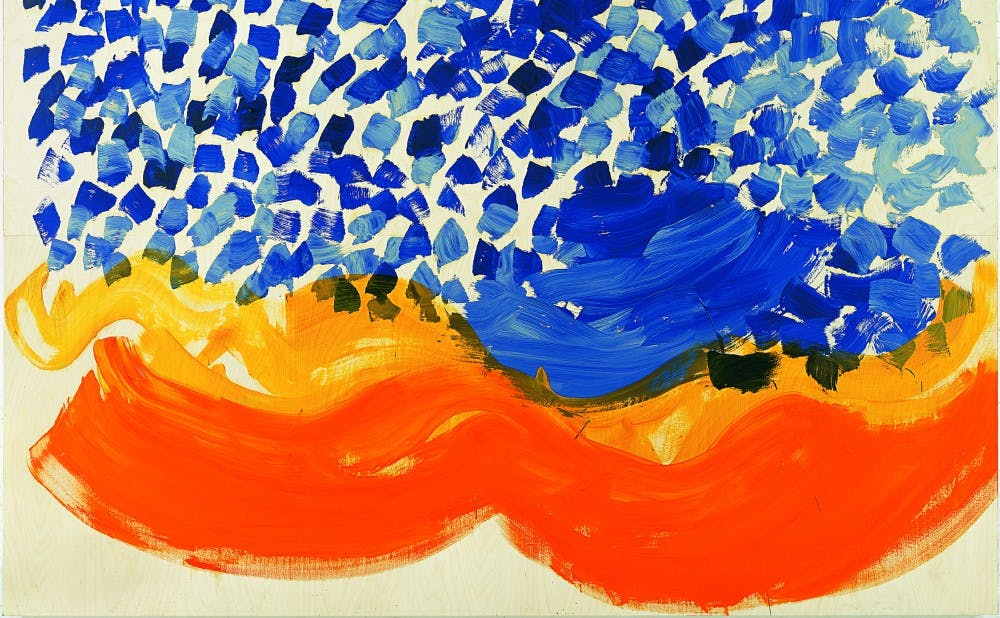When visitors walk into the Nasher exhibit “A Material Legacy: The Nancy A. Nasher and David J. Haemisegger Collection of Contemporary Art,” they are immediately greeted by a large stainless steel circle, which presents a distorted view of the image behind the visitor. This art piece, entitled “Full Moon” by Anish Kapoor, is the first of many pieces within the exhibit to contain more unusual materials.
“A Material Legacy” opened last week and contains 35 pieces, all of which use materials in a new or interesting way. Some of these materials include found objects, spools of thread, Styrofoam, an animal skull and Plexiglass. Marshall Price, Nancy Hanks Curator of Modern and Contemporary Art, described the exhibit as a “bookend to the Nasher’s tenth anniversary” to celebrate Nancy Nasher and David Haemisegger as the pieces selected for the show all come from their collection.
Nasher and Haemisegger are the daughter and son-in-law, respectively, of the original benefactors of the Nasher Museum, Raymond D. and Patsy R. Nasher. Nasher and Haesmigger’s collection has never been viewed by the public before, making its debut at the Nasher a special experience.
“It is the legacy of philanthropic collecting, but also it is the legacy of the artists in the exhibition and their innovative use of materials,” Price said.
The show also stands out in the newness of its pieces—most of the works in it were created within the last ten years. Every piece in the show is also major work from prominent contemporary artists, meaning that they are artists’ most important or most recent projects.
“It really provides a real-time glimpse into what is happening in the contemporary art world right now,” Price said.
Sarah Schroth, the museum’s Mary D.B.T and James H. Semans Director, approached Nasher and Haesmigger with the concept of putting on an exhibition of their collection. Although the couple was hesitant at first, as they did not see their art as a formal collection, they agreed to lend it in the end.
“It’s a response all collectors give when the museum person asks them to show their collection, because it’s the first time and they don’t think of themselves as a collector with an end or a theme in mind,” Schroth said. “They’re literally buying what they like. But what they like is pretty amazing.”
After Nasher and Haemisegger agreed to contribute their works to an exhibit, Price stepped in to select which pieces would be shown at the Nasher. In the end, he ended up selecting roughly one-tenth of the entire collection. Price worked on the exhibit for about a year and a half.
Installation of the exhibit only took two weeks, but some of the pieces proved challenging to install due to their immense size or weight.
Schroth especially enjoyed being able to look at the differences between the tastes of Nasher and Haemisegger and those of the older Nasher generation. When the museum first opened, Schroth—then a senior curator—curated an exhibit containing the works of Raymond and Patsy Nasher entitled “The Evolution of the Nasher Collection.”
“I knew what the parents’ taste was, and for me it was fascinating to see the difference,” Schroth said.
Schroth took over as director of the Nasher in 2013, and has since taken the museum in new directions. Last fall, the Nasher reinstalled a selection of the permanent collection. Although in the past the museum would use two-thirds of its space for special exhibits and one-third for its own collection, the museum now uses two-thirds of its space for its own collection and only one-third for special exhibits like “A Material Legacy.”
The exhibit will remain at the Nasher until June 26. After the show closes, it will journey to Princeton, where Haesmigger and Nasher first met, to be put on display at the Princeton University Art Museum.
Price hopes that students will be able to both enjoy the exhibition and learn from it.
“There are a lot of opportunities for wonder, amusement, education within the exhibition,” Price said.
Get The Chronicle straight to your inbox
Sign up for our weekly newsletter. Cancel at any time.

